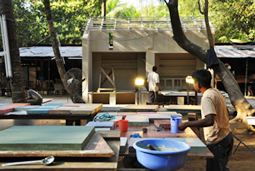 |
|
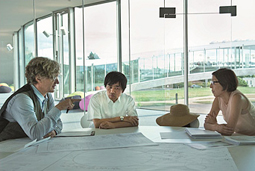 |
| Studio Mumbai, SMA Workshop, 2011.
Photo © Studio Mumbai |
|
Wim Wenders, If Buildings Could Talk . . ., 2010. From left: Wim Wenders, Ryue Nishizawa, and Kazuyo Sejima.
Photo © Donata Wenders |
Architects Kazuyo Sejima and Ryue Nishizawa, partners in the 2010 Pritzker Prize-winning firm SANAA, have assembled 28 architects and artists from 14 countries in an exhibition entitled Architectural Environments for Tomorrow - New Spatial Practices in Architecture and Art, currently at the Museum of Contemporary Art Tokyo (MOT). Together with chief curator Yuko Hasegawa, they've invited established practitioners such as Toyo Ito and Frank O. Gehry to exhibit their work alongside young, rising stars like Akihisa Hirata and Haruka Kojin. The full list of exhibitors, which can be found on the MOT website, reads like a reunion party for the 2010 Venice Architecture Biennale, which Sejima directed. For Architectural Environments for Tomorrow, participants were asked to present proposals "aspiring towards a new kind of sensation, philosophy or experience," and to demonstrate how they respond to and transform their surroundings. Of the exhibition Sejima said, "we hope to see the entire museum functioning as an expression of diversity."
The exhibition is centered around SANAA's recently completed Rolex Learning Center, located on the Ecole Polytechnique Fédérale campus in Lausanne, Switzerland. A room-sized model of this low-slung, undulating expanse of concrete and glass, presented at eye-level, is the first piece in the display sequence. The building is conceptually provocative, and structurally and spatially innovative. It combines an array of campus and public facilities with slopes and terraces around a series of internal "patios." Campus president Patrick Aebischer said that the Rolex Learning Center "exemplifies our university as a place where traditional boundaries between disciplines are broken."
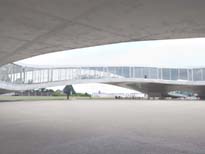 |
|
 |
| SANAA, Rolex Learning Center, 2010.
Photo © SANAA |
|
Matthew Ritchie with Aranda/Lasch, Daniel Bosia & Arup AGU, The Dawn Line (Sun Dog Variant), 2009. Photo © Jason Mandella, courtesy Andrea Rosen Gallery, New York |
It seems that breaking hierarchical boundaries is what SANAA set out to do through the exhibition as well. In the same display space as their Rolex Learning Center is a conceptual model, nearly as large, entitled Architecture Farm, by Akihisa Hirata. One of many emerging architects in Architectural Environments for Tomorrow, Hirata shows numerous models that together make an arresting study of skin and form. Visitors will have already encountered Hirata's Bloomberg Pavilion, located on the museum plaza. This new exhibit venue opened concurrently with the exhibition and will remain open for a year. It is the second iteration in a series that aims to support young artists and improve accessibility to art by housing a rotation of monthly exhibits. The pavilion's white light-gauge skin consists of repeated panels -- all in the same size and isosceles triangle shape -- composed into what appears to be a crumpled piece of paper.
The focus on urban environments shifts toward the developing world where an entire room of the exhibition is dedicated to the work of Studio Mumbai. Founder Bijoy Jain is a U.S.-trained architect who spent his formative years practicing in Richard Meier's office before returning to his native India, where he established this prolific practice. His work may be read simply as "modern vernacular," but his thoughtful drawings and sketchbooks on display invite a closer look. Large-scale models and often full-scale material mock-ups allow Jain to communicate his modern intentions to a team of local bricklayers and carpenters. Careful consideration is given to "traditional skills, local building techniques, materials, and an ingenuity arising from limited resources." According to Sejima, Architectural Environments for Tomorrow aims to highlight "the discoveries that are made when universal architectural expression . . . is fused with local wisdom and technology."
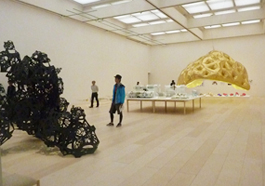 |
|
 |
| Study models for the Taichung Metropolitan Opera House by Toyo Ito (center) are displayed between works by emerging artists such as The Dawn Line by Matthew Ritchie (foreground) and The Golden Dome by AMID.cero9 (background). Photo by Nicolai Kruger |
|
A close-up of the exhibition's centerpiece: the room-sized model of the Rolex Learning Center, Lausanne, Switzerland, by Kazuyo Sejima + Ryue Nishizawa / SANAA. Photo by Nicolai Kruger |
The theme of breaking traditional boundaries is seen throughout the exhibition. A large-scale, floating conceptual piece called The Golden Dome, by the emerging Spanish firm AMID.cero9, is positioned next to detailed models of the Taichung Metropolitan Opera House by architectural heavyweight Toyo Ito. Cloudscape is an international and cross-disciplinary partnering between a Japanese newcomer, architect Tetsuo Kondo, and the German climate engineering firm Transsolar. The Dawn Line (Sun Dog Variant) is the result of a collaboration between artist Matthew Ritchie, architects Aranda/Lasch, and structural engineers from Arup AGU, Daniel Bosia, and Nicolas Sterling. Not unlike Hirata's Bloomberg Pavilion, The Dawn Line has an open cellular structure that is a feat of artistry and engineering (although Ritchie refers to it as an "anti-pavilion"). The jet-black, fractal-inspired planes guide visitors into the final space in the display sequence where a short film entitled If Buildings Could Talk . . . is screening. As if to remind visitors of this exhibition's true piece de resistance, filmmaker Wim Wenders was commissioned to create If Buildings Could Talk . . . about SANAA's Rolex Learning Center. It is worth noting that in addition to this SANAA project, Sejima and Nishizawa each have pieces in the exhibition under their own independent practice names as well.
Whatever one might think of Sejima's and Nishizawa's work and their relentless self-promotion, no one can deny that they have a far-reaching influence on budding architects. Environments for Tomorrow is a projection of where SANAA believes we are headed. It is an ambitious pursuit of material possibilities and fluid interaction between disciplines. SANAA should be commended for bringing this collection of creators together in Japan to inspire the next generation.
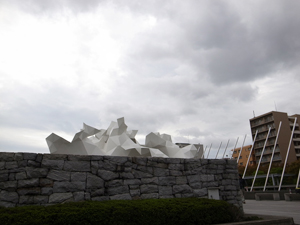 |
Sitting on the plaza in front of the Museum of Contemporary Art Tokyo, the Bloomberg Pavilion by Akihisa Hirata will hold monthly rotating exhibits until October 2012.
Photo © Akihisa Hirata Architecture Office |
|